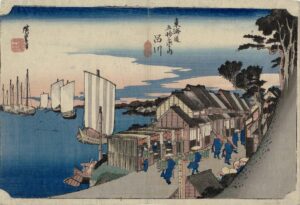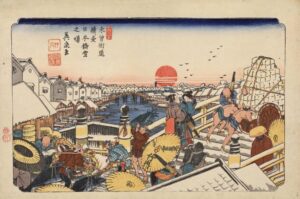The Journey Begins: Nihonbashi—Hiroshige’s First Step on the Tōkaidō
The Journey Begins: Departing from Edo
You are now a traveler in Edo.
The city is still cloaked in darkness, with only the faintest hint of dawn appearing in the eastern sky. A soft crimson glow begins to spread, signaling the arrival of a new day. The crisp morning air bites at your cheeks, and the sound of footsteps echoes against the stone-paved streets.
But unlike the rest of the city, Nihonbashi is already bustling with life.
Nihonbashi: The Starting Point of the Tōkaidō Journey
Before you stands the grand Nihonbashi Bridge. From the opposite side, an elaborate daimyo procession emerges, led by retainers carrying spears. Their disciplined march exudes an air of power and dignity. Meanwhile, on this side of the bridge, fishmongers pause briefly to let the procession pass. These men, known as bōtefuri, roam Edo selling fresh fish, balancing large buckets on a wooden yoke. Inside, lively red snapper and bonito glisten in the dim morning light.
At their feet, two dogs playfully nudge each other, oblivious to the solemnity of the scene. Amidst the formality and tension of the moment, this small glimpse of everyday life adds warmth and familiarity.
Utagawa Hiroshige’s “Nihonbashi: Morning Scene” masterfully captures the anticipation and solemnity of setting out on a long journey. Traditionally, Nihonbashi was depicted from a side view, featuring Edo Castle and Mount Fuji in the background. However, Hiroshige deliberately chose a different perspective, presenting the bridge head-on. This composition places the viewer directly at the threshold of the journey, inviting them to step forward into the adventure.
The Reality of Travel in the Edo Period
For travelers in Edo, setting out at 4 a.m. was the norm. The phrase “Oedo Nihonbashi Nanatsu-dachi” (Setting off from Nihonbashi at the hour of the hare) reflects this early departure. In the dim pre-dawn light, travelers would cross the bridge and make their way toward the first post town, Shinagawa-juku. Dressed in straw sandals and travel cloaks, they shouldered their belongings and slowly left the city behind.
But travel in the Edo period was not an easy feat. In the beginning, only feudal lords (daimyo) and their retainers journeyed along this road for the mandatory alternate attendance system (sankin-kōtai). Later, as travel restrictions eased, commoners, monks, and even women began making religious pilgrimages as an excuse to embark on the long road.
The cost of traveling from Edo to Kyoto round-trip was approximately 2 ryō (the equivalent of about 260,000 yen or $1,800 today). With lodging, meals, and various travel expenses included, it was far from affordable. And yet, people longed to embark on a journey, to step beyond the familiar confines of their lives and experience the world beyond Edo.
Nihonbashi Today
Standing on Nihonbashi today, you will no longer see the travelers of old. The bridge is now surrounded by towering skyscrapers, bustling traffic, and the constant movement of modern Tokyo. However, its role as the starting point of Japan’s highways remains unchanged. It is still the country’s zero milestone, marking the beginning of all major roads leading out of the capital.
For centuries, this was the gateway to adventure. As you stand here, looking at the bridge, Hiroshige’s world comes to life—an Edo morning, filled with the anticipation of departure.
Step forward. The journey has begun.
What awaits ahead? Let’s continue to the first post town—Shinagawa-juku.
Morning View of Nihonbashi (日本橋 朝之景)
Artist:Utagawa Hiroshige I (初代目歌川広重 (Japanese, 1797–1858))
Publisher:Tsuruya Kiemon (鶴屋喜右衛門)
Date:1834
Medium:Color woodblock print (nishiki-e); ink and color on paper
Dimensions:Horizontal ōban; overall: 9 5/8 × 14 1/4 in. (24.4 × 36.2 cm)
Portfolio:Fifty-three Stations of the Tōkaidō (東海道五拾三次)


